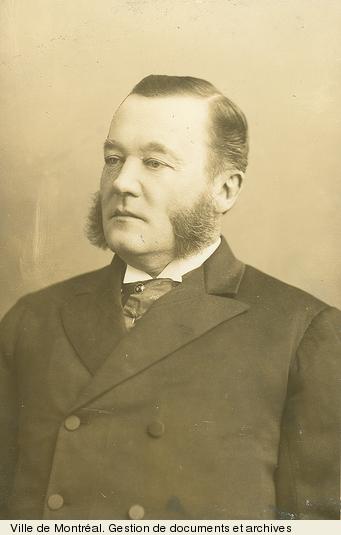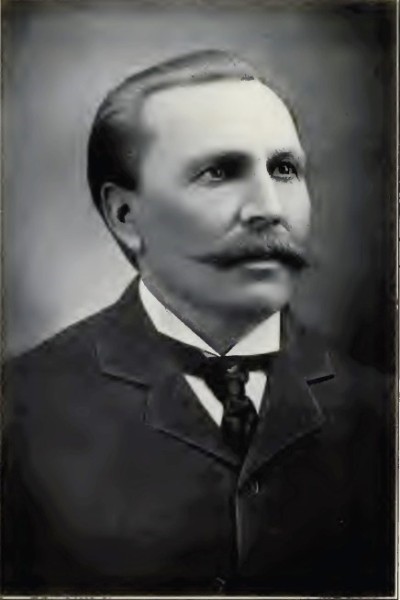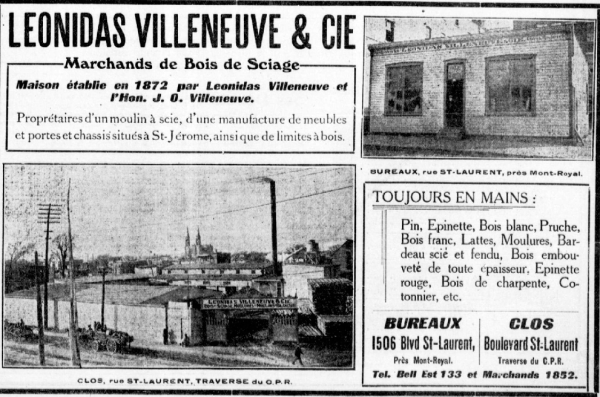The 1880-1910 period begins the decisive transformation of the Mile End: villas, farms, and residences of craftsmen living near their place of work gave way to a new town. The village received town status in 1895, and became a district of Montreal on January 1, 1910. In 1881, three years after the village was incorporated, Saint-Louis still had only 1,537 inhabitants. The explosion occurred after that. Its population increased from 3,500 inhabitants in 1891 to almost 11,000 in 1901 and 37,000 in 1911, making it the fastest growing suburb on the island of Montreal.1
After the church and train station (two keystones of the Beaubien family’s urbanization strategy), a third element contributed decisively to this expansion: the industrial revolution, not only because of its huge demand for labour, but also because it led to the emergence of a new middle class, comprised of skilled workers and white-collar employees. This up-and-coming portion of the population was the target of choice for the developers of the new suburbs. But for things to fall into place, something extra was needed: development of efficient transit, in the form of the electric streetcar. Its arrival gave the real estate speculators the signal that times were ripe to create new neighbourhoods. In the case of Plateau Mont-Royal, the electric streetcar was even more necessary, given the geographic obstacle created by the steep grade between Ontario and Sherbrooke streets.
In describing this period of accelerated urbanization—particularly between 1880 and 1910—historians, geographers and urban planners discuss the distinction between the walking city (where most people travelled on foot) and the streetcar suburbs. This transformation of the urban space gave rise to the a new generation of promoters, key players in the development of space, as Paul-André Linteau ably demonstrated in his study of Maisonneuve, a similar district. Men of action, who were often simultaneously speculators, major landowners, entrepreneurs and politicians, the dream of this type of developer was to create an entire town from scratch:
In contrast to the pure speculator, he was not content to wait for the land values to increase; he caused the increase by helping modify the landscape in which his property was located.(…)
The developer worked to enhance the value of a site. Accessibility was a prime factor. Access was sometimes organic, but more often it needed to be created. The role of transportation was crucial: a railway or streetcar were essential to the success of the developer’s projects….In these circumstances, it is hardly surprising there were strong links between developers and the public transportation companies.2
Joseph-Octave Villeneuve, grocer, entrepreneur and mayor
In the case of the adjoining villages of Saint-Jean Baptiste and Saint-Louis du Mile End, two cousins played this key role: Joseph-Octave and Leonidas Villeneuve were literally to be their “sponsors”. Joseph-Octave (1836-1901), the older brother, is the better known. He was a “self-made-man” of the American archetype; poorly educated, he started in the retail trade at a young age. On July 12, 1856, Stanley Clark Bagg rented him the Mile End Tavern, located on Sainte-Catherine Road3 on the northwest corner of Saint-Laurent. In return, Joseph-Octave Villeneuve, then only 20 years old, agreed to pay him the sum of £50 per year, as well as £4, 3 shillings and 4 pence per month, and “repair the bowls and install two new gaming tables.” The building was described as a two-storey stone house, with stables, sheds and two gardens.4
The following autumn, on September 8, Stanley Clark Bagg signed a five-year lease with Joseph-Octave for a one-arpent lot fronting Saint-Laurent Street, just across from the tavern (inn) on the southwest corner. In exchange, Villeneuve agreed to construct a building with a 32-foot frontage and an 18-foot depth. It was to be a “good building” to serve as “butchers stalls or grain stores, which he was to possess.” The lease provided for Stanley Clark Bagg’s taking over the buildings if Joseph-Octave reneged on his obligations.5 Stanley Clark Bagg need not have worried, because Villeneuve’s business became a prosperous store:
J.-Octave Villeneuve started as a “corner grocer” and patiently expanded his business, which became the firm J.-O. Villeneuve & Co. wholesale grocers. To be clear, the wholesale grocery did not sell only to retailers. Its customers included large families, who grouped together in twos or threes and bought their provisions by the sack or the case. The wholesale grocery store was for family patriarchs.6
In 1860, Joseph-Octave got involved in transportation by creating the Mile-End Omnibuses, a shuttle service between Saint-Jean Baptiste and Terrebonne, his family village, promoting commercial links between the two. All these strategies were designed to reinforce the status of the Saint-Laurent/Mont-Royal intersection as a strategic crossroad. As his biographers noted, this was a gamble:
Villeneuve had established his enterprise in the heart of a village [Saint-Jean-Baptiste] to which, in the aftermath of the great Montreal fire of 1852, workmen, craftsmen, and speculators had flocked, looking for cheap lots and lodgings With its wooden houses and lack of the most elementary public services, the village was a shabby place, its air polluted by dust from the lanes, by open sewers, and by smoke from limekilns. But Villeneuve foresaw that it would have a great future, even though the absence of a river or railway scarcely augured well for its industrial development.7
Although Saint-Jean-Baptiste did not have the resources to become a centre of the industrial revolution—unlike the Lachine Canal area of that time—Villeneuve was right to focus on its development as a residential suburb. As a transportation entrepreneur, he understood that the arrival of the streetcar would make access to the Plateau easier for the thousands of rural workers attracted by employment in the new factories and needing housing. The Mile End crossroad could become more than just a stop for travellers—such as farmers selling their products in the city—or a place of leisure for workers from the surrounding quarries. It could become the linchpin of a new municipality. When he became mayor in 1866, Saint-Jean Baptiste, which had separated from Côte Saint-Louis in 1861, was already a village over 4000 inhabitants. Joseph-Octave Villeneuve continued as mayor until annexation to Montreal in 1886. By then, the village, by then a town, had more than 15,000 residents.8
In 1869, Villeneuve sold his transportation company for $400 to businessmen who wanted to extend the rails of the Montreal City Passenger Railway Company’s horse tramway northward. This did not stop him from starting up a new transportation company the following year, the Terrebonne and Back River Omnibuses. Villeneuve reinvested a portion of the profits from his business in the purchase of landholdings along Saint-Laurent Street. According to Bell Canada archives, until 1882, “J.O. Villeneuve grocer”, was the telephone customer in the entire district”.9 His business sense did not stop there: in 1875, he joined his cousin, Leonidas, to launch a construction materials company, which provided the area with everything needed for urban development: wood, sawing, tar, gravel, etc.
Léonidas Villeneuve, wood merchant, entrepreneur and Mayor
Léonidas (1849-1913) was, in fact, as active as his cousin. They apparently divided the area into two. One took care of Saint-Jean-Baptiste, the other, Saint-Louis du Mile End. Born in Sainte-Anne-des-Plaines in Terrebonne County like his cousin, Léonidas was a farmer’s son and poorly educated. But wood selling seemed to be in his blood. His older cousin—already an established merchant and politician—gave him a boost when they became partners. One had a network of contacts in the political and commercial establishment of the time, the other opened a new sphere of activity and add new territory to the family empire.
Although mayor of Saint-Jean Baptiste, Villeneuve still supported Louis Beaubien during the 1875 provincial election campaign. Beaubien was criticized for reneging on his promise when he located the train station in the middle of his holdings instead of further south in the village of Saint-Jean Baptiste.10 This support had all the appearances of being a close political and commercial alliance. Political, first of all, because the three men were part of the ultramontane wing of the Conservative Party. In fact, Joseph-Octave Villeneuve succeeded Louis Beaubien as representative of Hochelaga in the provincial legislature, when Beaubien left politics in 1886.11 Commercial, because the opening of Mile End Station in 1876 allowed for northward expansion of the two cousins’ various businesses.
In 1878, Leonidas Villeneuve & Co, Dealers in Lumber opened a large lumber yard located at 2 Saint-Laurent—just behind Mile End Tavern—on land leased from the Bagg family.12 Consequently, the Villeneuve cousin’s business became the prime destination for wood transported by the railway created through the efforts of Louis Beaubien! They held a prominent location in Saint-Louis du Mile End the very year that village separated from Côte Saint-Louis. The opening of a permanent station led to larger commercial operations in the area. Firewood undoubtedly was delivered, but construction wood needed for urbanization of Plateau Mont-Royal was more important. The company was strategically located between the new station, untouched land further north, and the burgeoning district to the south. At its peak, in addition to its Montreal operation, L. Villeneuve and Co. owned in woodlots in the Laurentians and a sawmill at Saint-Jérôme.13
Léonidas used the same strategy as Joseph-Octave and became involved in the new town’s politics: he was elected councillor or mayor of Saint-Louis du Mile End for almost the entire period between 1883 and 1900.14 But this did not prevent his company from benefiting from receiving contracts from the town. To provide only one example, L. Villeneuve and Co supplied materials for construction of the sewers of Saint-Louis du Mile End.15
Moreover, two contemporary biographers of Léonidas Villeneuve pointed out that he invested the profits of his companies to purchase land in the village even before the start of the urban boom:
[The profit derived from L. Villeneuve & Co] brought him substantial returns and his fortune also arose through his wise investments in real estate. From time to time he added to his holdings, and when there was a real estate boom in the district, he had extensive holding, a portion of which he sold, realizing therefrom a handsome fortune.
Mr. Villeneuve had purchased a large amount of real estate and when the realty opened in the Mile End district twenty years ago, it found him one of the heaviest land owners, and the rapid increase in values brought him a large fortune.16
But, above all, Leonidas Villeneuve was mayor of Saint-Louis du Mile End when it began the transition from a small village to an urban suburb. This is what we will examine in the next chapter.




